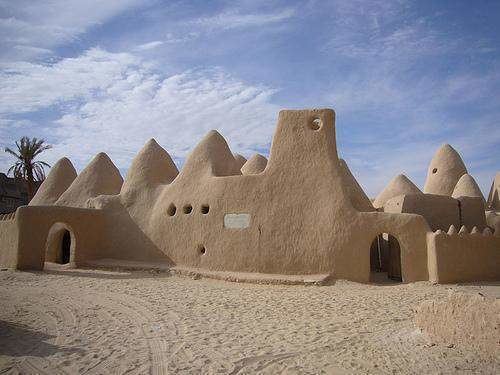Architectural type Mosque | Affiliation Islam Date established 12th century | |
 | ||
Similar Atiq Mosque, Benghazi Cathedral, Gurgi Mosque, Red Castle Museum, Tripoli Stadium | ||
The Atiq Mosque (also called the Great Mosque, or al-Kabir mosque) is a mosque in the oasis village of Awjila, in the Sahara desert of the Cyrenaica region of eastern Libya. The community dates back to classical times. Since being taken by the Arabs in the seventh century, Islam has always played a central role in the life of Awjila. The 12th-century mosque, the oldest in the region, has unusual conical domes made of mudbrick and limestone that provide light and ventilation.
Contents
Location
Awjila and the adjoining oasis of Jalu are isolated, the only towns on the desert highway between Ajdabiya, 250 kilometres (160 mi) to the northwest, and Kufra, 625 kilometres (388 mi) to the southeast. The oasis produces high quality dates. The people of the oasis are mainly Berber, and some still speak a Berber-origin language. As of 2005 the Awjila language was highly endangered. The mosque is located in the old city area of Awjila.
History
The Arabs launched a campaign against the Byzantine Empire soon after Muhammad died in 632, quickly conquering Syria, Persia and Egypt. After occupying Alexandria in 643, they swept along the Mediterranean coast of Africa, taking Cyrenaica in 644, Tripolitania in 646 and Fezzan in 663. The region around Awjila was conquered by Sidi 'Abdullāh ibn Sa'ad ibn Abī as-Sarḥ. His tomb was established in Awjila around 650.
After being introduced in the seventh century, Islam has always been a major influence on the life of the oasis. The Arab chronicler Al-Bakri says that there were already several mosques around the oasis by the 11th century. Starting in the 1960s, the oil industry drove growth in the once-sleepy village. By 1968, the population of the village had increased to about 2,000 people, and by 1982 it had risen to over 4,000, supported by twelve mosques.
Structure
The Great Mosque of Atiq is the oldest mosque in the region. The present building dates to the 12th century. It was restored in the 1980s. The oasis was a destination for viewing the Solar eclipse of 29 March 2006, and the mosque was again refurbished in preparation for the visitors.
There is a palm tree post on each side of the entrance gate to the mosque enclosure. The unusual mud brick building covers an area of 400 square metres (4,300 sq ft) and is roofed by 21 conical domes made of mud brick and limestone. Each dome has small openings so that light can enter the building. The domes also serve to keep the interior cool, providing a form of natural air conditioning.
The walls are 40 centimetres (16 in) thick. Nine doors lead into the interior of the building, where the many pillars and arches create a spacious, light, cool and calm environment. Beside the mihrab there is a recessed niche for the minbar, where the prayer leader stands. Mosques in Arabia and East Africa have similar minbar niches, which may indicate that the mosque builders followed the Ibadi school of Islam.
